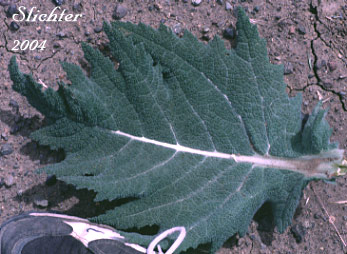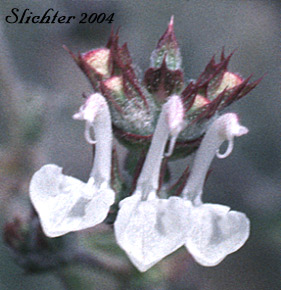The photo above shows the flowers of African sage as seen northeast of Plush, OR along the western base of Hart Mt.............June 30, 1997.
The photo above shows the flowers of African sage as seen northeast of Plush, OR along the western base of Hart Mt.............June 30, 1997.
 The photo at right shows the form of African sage as seen at
the state rest area along US 20 to the west of Hines, OR...............June
24, 2003.
The photo at right shows the form of African sage as seen at
the state rest area along US 20 to the west of Hines, OR...............June
24, 2003.
Also known as Mediterranean sage, African sage is a weedy biennial generally with a single erect, stout stem from 20-100 cm high. The stems are multi-branched, the branches spreading or ascending above the lower third of the stem. The leaves are largely basal, with a few large but reduced leaves on the lower half of the stem. The basal and lower stem leaves are petiolate with broad, ovate-oblong to widely elliptic or sometimes heart-shaped blades from 6-25 cm long. The margins of the blades are typically pinnately lobed, the lobes shallow (See photo below.), or sometimes coarsely toothed. The upper leaves are sessile with toothed margins. The uppermost leaves, or those at the tips of the branches are reduced to bracts from 1-2 cm long on opposite sides of the stem below each leaf axil. The stems leaves of younger plants bear tufts of long, soft, tangled hairs but both (especially the upper surface of the blades) become somewhat glabrous with age.
The inflorescence consists of several axillary cymes along each branch. The calyx is funnel-shaped, evidently veined and covered with tufts of long, soft, tangled hairs. Each of the 5 calyx lobes are irregularly sized and shaped, the lobes each ending in a long, narrow point. The corolla is pale yellow, about 1.-2.5 cm long and strongly two-lipped. The upper lip is strongly arched upwards and forward and is about as long or longer than the tube. It is notched at the tip. The lower lip is broader and three-lobed, the middle lobe very broad and very shallowly cup-shaped. The stamens are about as long as the upper lip and may either be hidden or barely exserted beyond them.
African sage is a weedy plant found on disturbed soils along roadsides or on overgrazed sagebrush to saltbrush flatlands, often on dry ice age lakebeds.
A native north Africa, African sage is found in the basins of southern Lake County in Oregon and at a number of other locations across central and southeastern Oregon.

